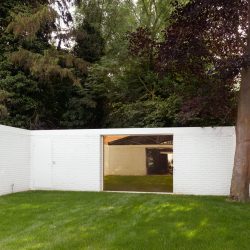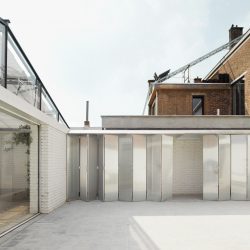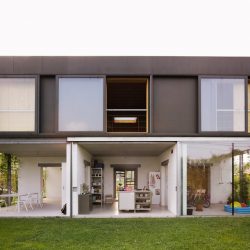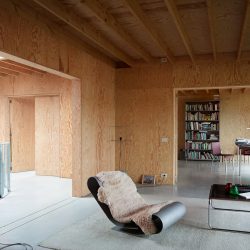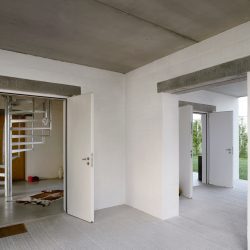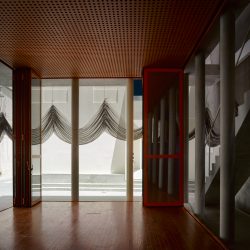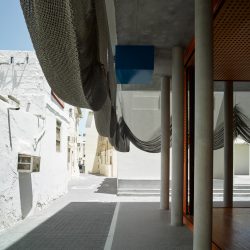‘AMBIGUITY’ AND ‘ANOMALY’ HAVE SERVED AS THE CORES BEHIND THE CONCEPTUALIZATION AND MATERIALIZATION OF THE ARCHITECTURE OF OFFICE KERSTEN GEERS DAVID VAN SEVEREN SINCE ITS FOUNDATION IN 2002. THE STUDIO’S DISTINCT CHARACTER IS DERIVED FROM THE SIMPLICITY OF THEIR GEOMETRIC FORMS THAT POSSESS A GREAT COMPLEXITY OF SOCIETAL ISSUES AND ARCHITECTURAL THEORIES. SUCH HAS LED OFFICE TO OBTAIN THEIR STATUS AS ONE OF BELGIUM’S MOST SUCCESSFUL AND PROMISING ARCHITECTURE STUDIOS. BACK IN THE DAYS WHEN KERSTEN GEERS AND DAVID VAN SEVEREN WERE STUDENTS OF ESCUELA TÉCNICA SUPERIOR DE ARQUITECTURA DE MADRID (ETSAM) WHERE THEY PURSUED THEIR STUDIES AFTER GRADUATING FROM BELGIUM’S UNIVERSITY OF GHENT, ABALOS & HERREROS, ONE OF SPAIN’S MOST PROMINENT ARCHITECTS OF THE 1990S, BECAME AN INFLUENCE DURING A TIME THAT PLAYED A SIGNIFICANT PART IN THE EVOLUTION OF THEIR ARCHITECTURAL LANGUAGE. THE CONTENT AND SCALE OF THEIR WORKS VARY FROM FURNITURE AND ARCHITECTURE TO MASTERPLANNING PROJECTS. THE STUDIO HAS RECEIVED A GREAT NUMBER OF AWARDS INCLUDING THE BELGIAN PRIZE FOR ARCHITECTURE IN 2009, 2013 AND 2015, TO THE VENICE BIENNALE FOR ARCHITECTURE’S SILVER LION AWARD IN 2010 GIVEN TO THE ‘MOST PROMISING YOUNG PRACTICE’ FOR THEIR REPUTABLE GARDEN PAVILION PROJECT. THE TWO PARTNERS HAVE FURTHER BEEN INVITED TO TEACH AT GLOBALLY RENOWNED UNIVERSITIES SUCH AS HARVARD GRADUATE SCHOOL OF DESIGN.
As you were beginning your career, how did you survive the first five years?
DVS: Well, we were working separately in other offices. Kersten was in Rotterdam and I was in Ghent and we had our office together but only on the weekends. We both didn’t work on Fridays so we would have three days for working on our own projects. So in the first moment, we were surviving on the fact that we were working for other offices, Kersten worked for Neutelings Riedijk and I worked for Xaveer De Geyter in Brussels. But on the other hand, we were interested in how can you as a practice just do things and also survive on that. Our first project was realized not only because it’s kind of an important project still. It means we still feel pretty related to it and what it tries to do even though it’s a small project. It was built in 2002 so that was more than 15 years ago. And it was our first commission and it sort of became our manifesto and income in terms of how we could survive on it. It was also our first built work that could be photographed. Very soon we learned that you could survive on architecture.

The house’s perspective reveals a glass gable roof that can slide open and closed to create a partitioned space for the entrance hall. The pool area adds greater diversity to the house’s functional space.
The ratio between the actual practice and having projects where you could only speculate if they were going to be built is still kind of the same nowadays.
DVS: Yes. It’s very similar, of course things have changed and we’ve become a bit more experienced but finally if you could imagine the parallel between what we were doing in the beginning and today, it’s pretty easy. We have more people working now and a higher level of professionalism and credibility that we have built throughout the 15 years. Nevertheless, we keep a certain openness to what we make and a sense of adventure even today and with each project whether it’s pitching or research or really building architecture. There’s a level of dreams and adventure still present in each of the days we work at our office.
Is there any logic behind naming your office ‘OFFICE’?
DVS: Well it was this first project, the Notary’s Office entrance. It was photographed by Bas Princen who we’ve been working with all the time since then. Somebody saw the photographs of the project we made and they immediately wanted to publish it. It was a Japanese magazine, A+U, and by coincidence they were making this issue about Belgium. It was called driving through Belgium. There were two parts Driving Through Belgium Part One and Part Two. We got into the publication by coincidence and we were very proud because our first project got published in an important magazine. But we needed a name and we were also kind of inspired by the paintings of David Hockney, John Baldessari, and everybody else, anyway these are just names of people but also in Belgian fashion you have all these icons that rose in the 90s like Dries van Noten, Raf Simons etc. and we kind of liked that directness of the names, of just the name as it is. So we decided to call our office OFFICE. OFFICE as a kind of word under which you can summarize everything and then the names to make it more specific; so it became OFFICE Kersten Geers David Van Severen, a very long name. Today we’re still struggling with that name but it’s still something we hold as being important and if you want to make a short version it’s not OFFICE KDGVS, we don’t like that. It’s OFFICE but the real version is OFFICE Kersten Geers David Van Severen. OFFICE somehow has this neutrality that we like but it’s already made not so neutral or more subjective when you put the names behind. Suddenly it becomes like this place where these two names have conditions.

The perspective from the back of the villa house in Belgium’s Buggenhout. Office manipulates the space by enclosing the garden to be in the same plane as the house’s wall, causing the space between the house and the perimeter of the land to be obscurely defined as a garden or a grassland.
I think it’s similar to the character of your office and how you like to play with duality.
DVS: Yes. And we also like ambiguity. We don’t like things to be clear from the start and people need to make their own interpretations or ideas of something. With the name there is already a certain, I call it, ambiguity. It’s office with two names but OFFICE is something neutral but it isn’t suddenly when you put the names behind it and so on. This kind of more layered approach to things is what we like a lot, also in our work.
On the philosophical level, why do you like the idea of ambiguity?
DVS: Because I think most great works in cultural production aren’t so easy, there are a lot of layers of ambiguity and interpretation because that’s why they can survive. There are a lot of examples that are not so clear about what they’re actually about but they have certain layers of understanding and misunderstanding and that allows them to survive somehow through fashion, in architecture or in painting, if you want to talk about painting. But it’s rather a kind of ambiguity that keeps them alive.
Read more in art4d 257, March 2018
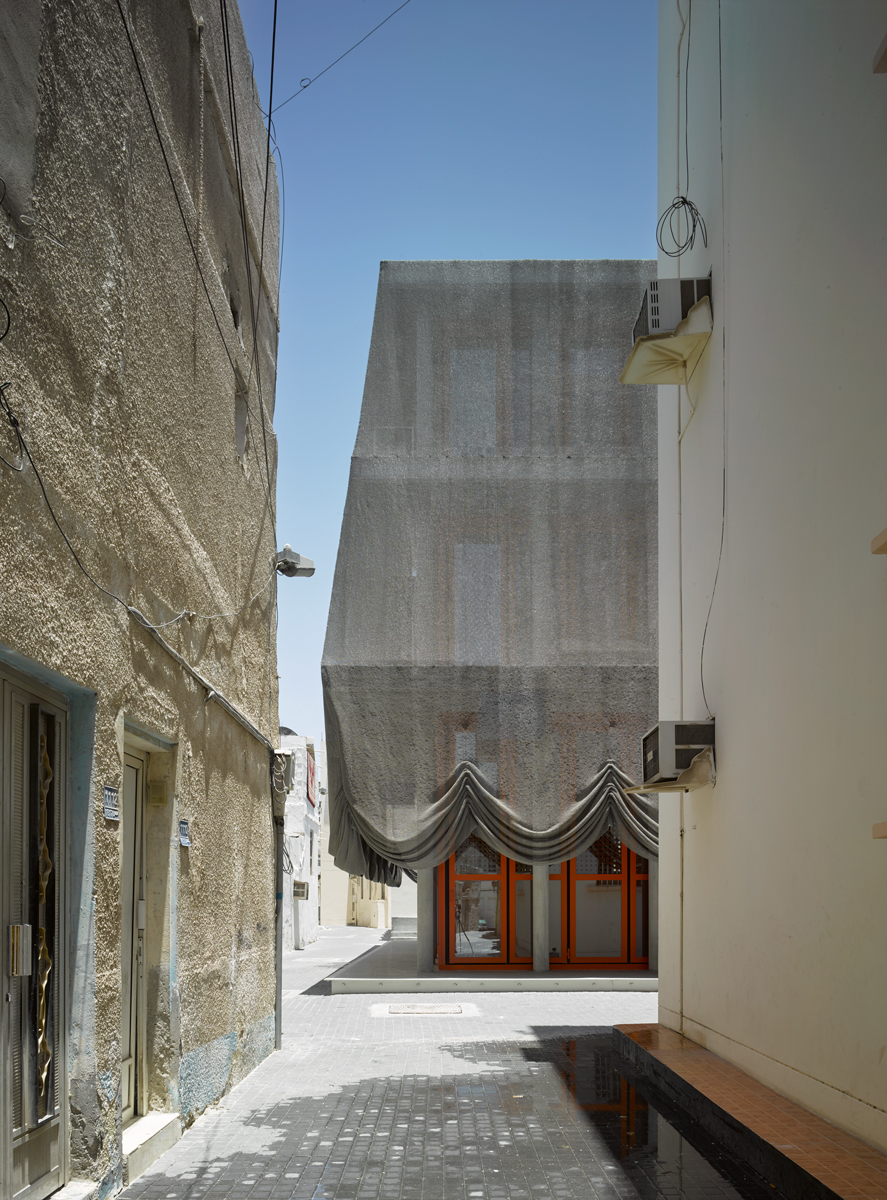
Steel mesh was used to enclose the building. Like a curtain, the mesh, with a design reminiscence of a veil worn by Muslim women, can be pulled up to open up the space for live performances.
“ความคลุมเครือ” (ambiguity) และ “ความไม่ปกติ” (anomaly) เป็นแนวคิดสำคัญที่อยู่เบื้องหลังผลงานสถาปัตยกรรมของ OFFICE Kersten Geers David Van Severen มาตั้งแต่เริ่มก่อตั้งในปี 2002 ด้วยความชัดเจนของคาแร็กเตอร์ที่เกิดจากความเรียบง่ายของรูปทรงเรขาคณิตพื้นฐาน แต่แฝงไว้ด้วยความซับซ้อนของประเด็นทางสังคมและความคิดทฤษฎีเชิงสถาปัตยกรรม เป็นเหตุผลงานให้ OFFICE เป็นหนึ่งในบริษัทสถาปัตยกรรมที่ประสบความสำเร็จและน่าจับตามองที่สุดบริษัทหนึ่งของเบลเยียม การที่ Kersten Geers และ David Van Severen ได้มีโอกาสศึกษากับ Abalos & Herreros สถาปนิกกลุ่มสำคัญของสเปนในช่วงทศวรรษที่ 90 ในขณะที่ทั้งคู่ศึกษาอยู่ที่ Escuela Técnica Superior de Arquitectura de Madrid (ETSAM) ภายหลังจากที่จบการศึกษาจาก University of Ghent ของเบลเยียม ถือเป็นส่วนหนึ่งของช่วงชีวิตที่มีอิทธิพลและหล่อหลอมแนวคิดทางสถาปัตยกรรมของพวกเขาให้มีความชัดเจนอย่างทุกวันนี้ ผลงานของ OFFICE มีความหลากหลายทั้งในแง่ของเนื้อหาและขนาดของผลงาน ตั้งแต่เฟอร์นิเจอร์ สถาปัตยกรรม ไปจนถึงการวางผัง masterplaning ต่างๆ พวกเขาได้รับรางวัลสำคัญมากมาย เช่น รางวัล Belgian Prize for Architecture ในปี 2009, 2013 และ 2015 และรางวัล Silver Lion ที่งาน Venice Biennale for Architecture ในปี 2010 ซึ่งมอบให้กับ ‘สถาปนิกรุ่นใหม่ที่มีแววที่สุด’ (Most Promising Young Practice) จากผลงาน Garden Pavilion ที่สร้างชื่อให้กับ OFFICE นอกจากนั้น ทั้งคู่ยังถูกเชิญไปสอนในมหาวิทยาลัยต่างๆ อีกด้วย เช่น Harvard Graduate School of Design
art4d: ในช่วง 5 ปีแรกของการเริ่มเป็นสถาปนิก พวกคุณเอาตัวรอดกันมาได้ยังไง
DVS: เรายังไม่ได้ทำงานด้วยกัน Kersten ทำงานอยู่ใน Rotterdam ส่วนผมอยู่ที่ Ghent เราทำงานด้วยเฉพาะในวันหยุดสุดสัปดาห์ เราทั้งคู่ไม่ได้ทำงานประจำกันในวันศุกร์ ทำให้เรามีเวลา 3 วันทำโปรเจ็คต์ของตัวเอง ดังนั้นในช่วงแรก เราอยู่รอดได้ก็เพราะเรายังคงเป็นลูกจ้างให้กับสำนักงานอื่นอยู่ Kersten ทำกับ Neutelings Riedijk ส่วนผมทำที่ Xaveer De Geyter ในบรัซเซล แต่อีกด้านหนึ่ง เราก็สนใจว่าจะทำยังไงเราถึงจะอยู่รอดได้ด้วยการทำงานที่เราชอบ ที่โปรเจ็คต์แรกของเราเกิดขึ้น ไม่ใช่แค่เพราะมันเป็นโปรเจ็คต์ที่สำคัญอย่างเดียว แต่เกิดขึ้นเพราะเรารู้สึกว่ามันเป็นสิ่งที่เราต้องการจะทำจริงๆ ถึงจะเป็นโปรเจ็คต์เล็กๆ ก็ตาม มันถูกสร้างปี 2002 ซึ่งก็ 15 ปีมาแล้ว เป็นงานคอมมิชชั่นงานแรกของเรา และเป็นเหมือนกับการประกาศตัวของออฟฟิศ และสิ่งยืนยันว่าเราสามารถมีชีวิตรอดในแนวทางนี้ได้จริงๆ โปรเจ็คต์นี้เป็นเป็นงานแรกที่สร้างจริง ไม่นานหลังจากนั้น เราก็รู้ว่าเรามีชีวิตอยู่ได้ด้วยวิชาชีพสถาปนิก
art4d: สัดส่วนระหว่างงานที่จะสร้างจริง กับโปรเจ็คต์ที่ก้ำกึ่งว่าจะสร้างจริงหรือไม่ได้สร้างของคุณตอนนี้ยังเหมือนเดิมรึเปล่า
DVS: ใช่ ไม่ต่างกันเท่าไหร่ ถึงแม้อะไรหลายๆ อย่างจะเปลี่ยนไปและเรามีประสบการณ์มากกว่าตอนนั้น แต่สุดท้ายแล้วถ้าคุณพอจะนึกภาพออก เปรียบเทียบการทำงานในอดีตกับการทำงานในตอนนี้ คุณก็น่าจะพอเห็นว่า ตอนนี้มันง่ายกว่ามากเพราะเรามีทีมงานมากขึ้น มีความเป็นมืออาชีพและความน่าเชื่อถือที่เราสร้างมาตลอด 15 ปี อย่างไรก็ตาม เราก็ยังคงเปิดกว้างให้กับสิ่งที่เราจะสร้างเหมือนเดิม รวมทั้งยังคงจิตวิญญาณการผจญภัยแบบเดิมๆ เอาไว้ ไม่ว่าจะในการทำงานรีเสิร์ช งาน pitching หรือโปรเจ็คต์ที่จะต้องสร้างจริง ความฝันและจิตวิญญาณของการผจญภัยของเรายังคงอยู่ในการทำงานของเราถึงตอนนี้
art4d: ชื่อ OFFICE มีความหมายอะไรซ่อนอยู่ไหม?
DVS: มันเกิดขึ้นตอนเราทำโปรเจ็คต์แรก คือทางเข้าของ Notary’s Office โปรเจ็คต์นี้เราได้ Bas Princen ที่เราร่วมงานกันมาตลอดมาเป็นคนถ่ายภาพให้ สื่อหลายที่เห็นภาพนั้นและอยากจะตีพิมพ์เกี่ยวกับโปรเจ็คต์นี้ หนึ่งในนั้นคือ A+U นิตยสารญี่ปุ่น ที่เขากำลังทำเล่มพิเศษเกี่ยวกับเบลเยี่ยมพอดี เล่มนั้นแบ่งเป็นสองส่วนคือ Driving Through Belgium Part One และ Driving Through Belgium Part Two เราเปิดนิตยสารเจอโปรเจ็คต์ของเราในเล่มโดยบังเอิญ และเราก็ภูมิใจมากเพราะมันเป็นโปรเจ็คต์แรกที่ถูกตีพิมพ์ในนิตยสารหัวใหญ่ๆ แบบนี้ ทีนี้ เราก็เลยต้องมีชื่อออฟฟิศแล้วล่ะ พวกเราค่อนข้างได้รับแรงบันดาลใจจากจิตรกรรมของ David Hockney, John Baldessari แล้วก็ยังมีศิลปินคนอื่นๆ อีก สำหรับคนทั่วไป ชื่อเหล่านี้คงไม่มีความหมายอะไร แต่สำหรับคนเบลเยี่ยมนั้นไม่ใช่ ทุกคนคงเคยได้ยินชื่อไอคอนยุค 90s ไม่ว่าจะเป็น Dries van Noten หรือ Raf Simons เราชอบชื่อที่ตรงไปตรงมาแบบนั้น ชอบชื่อที่เป็นแค่ชื่อ เราเลยตัดสินใจเรียกออฟฟิศตัวเองตรงๆ เลยว่า ‘OFFICE’ Office เป็นคำที่เข้าใจได้ง่าย แต่เพื่อที่จะทำให้มันเจาะจงมากกว่านั้น เราเลยเติมชื่อตัวเองต่อท้ายไปจนออกมาเป็นชื่อ OFFICE Kersten Geers David Van Severen ที่ยาวมากๆ ซึ่งตอนนี้เราลำบากกับการใช้ชื่อนี้พอสมควร แต่มันก็เป็นสิ่งที่สำคัญที่เรายังรักษาเอาไว้ ถ้าคุณอยากจะทำให้มันสั้นลงโดยเรียกเราว่า OFFICE KGDVS ผมต้องบอกตรงนี้ว่าผมไม่ชอบใจเท่าไหร่ ชื่อย่อจริงๆ คือ OFFICE แต่ถ้าจะเรียกแบบเวอร์ชั่นเต็มก็ต้องเป็น OFFICE Kersten Geers David Van Severen ชื่อ OFFICE มันมีความเป็นกลางอยู่ คือเราก็ชอบนะ แต่เราทำให้มันไม่เป็นกลางและเฉพาะเจาะจงขึ้นแล้ว โดยการเติมชื่อพวกเราต่อท้ายเข้าไป ท้ายที่สุด มันก็คล้ายกับว่าชื่อของออฟฟิศสองชื่อนี้มีสองเงื่อนไขในตัวมันเอง
art4d: มันคงเหมือนกับคาแร็คเตอร์ของออฟฟิศ ที่คุณชอบเล่นกับความเป็นคู่ (duality)
DVS: ใช่ แล้วเราก็ชอบความกำกวม เราไม่ชอบอะไรที่มันชัดเจนตั้งแต่เริ่มต้น เราอยากให้คนได้ตีความด้วยตัวเอง หรือใช้ความคิดของตัวเอง อย่างเรื่องชื่อออฟฟิศของเรานี่ก็เหมือนกัน คำว่า OFFICE เฉยๆ มันจะมีความกลาง แต่พอใส่ชื่อของเราสองคนตามหลังเข้าไป ความรู้สึกมันจะเปลี่ยนไปเลยทันที นี่เป็นวิธีการสร้างมิติให้กับบางสิ่งบางอย่างที่เราชอบและมันปรากฏในงานออกแบบของเรา
art4d: ในเชิงปรัชญา คุณชอบอะไรในไอเดีย “ความคลุมเครือ” (ambiguity) นี้
DVS: ผมคิดว่าผลงานที่ยิ่งใหญ่ ที่เป็นส่วนหนึ่งในกระบวนการสร้างวัฒนธรรมมันไม่ได้เกิดขึ้นมาง่ายๆ มันเต็มไปด้วยมิติของความคลุมเครือและการตีความหลายๆ ชั้น และนี่เป็นเหตุผลว่าทำไมมันถึงยังมีชีวิตอยู่ เราจะเห็นว่าหลายๆ ผลงานที่ไม่ได้บอกตรงๆ ว่าหมายถึงอะไร ผลงานประเภทที่ถูกซ้อนด้วยชุดเหตุผลของความเข้าใจ และความเข้าใจผิดหลายๆ ชั้นนั้น มันยังคงมีชีวิตอยู่ ไม่ได้ถูกใช้แล้วทิ้งหรือสูญเสียความสำคัญไปท่ามกลางกระแสของความเปลี่ยนแปลง ทั้งงานสถาปัตยกรรมและงานจิตรกรรม ถ้าพูดถึงในกรณีของจิตรกรรม มันยิ่งชัดเจนเลยว่าความคลุมเครือที่ว่าทำให้งานไม่ตาย
อ่านต่อใน art4d ฉบับ 257 มีนาคม 2561
INTERVIEWED BY KRAIPOL JAYANETRA
PHOTO : BAS PRINCEN, COURTESY OF OFFICE KERSTEN GEERS DAVID VAN SEVEREN
officekgdvs.com


